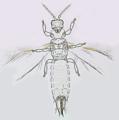Chaetanaphothrips signipennis
Recognition data
Distinguishing features
Female fully winged. Body colour yellow, fore wing pale with brown cross-bands at base and medially; antennal segments V & VI with apex brown. Antennae 8-segmented, VII & VIII slender, III & IV with sensorium slender and forked. Head wider than long; 3 pairs of ocellar setae present, pair III between anterior margins of hind ocelli. Pronotum with 1 pair of major posteroangular setae. Metanotum weakly reticulate, median setae small and placed well behind anterior margin. Fore wing slender, first vein with 3 setae on distal half, second vein with 3 or 4 setae. Tergites without sculpture medially, posterior margins with complete craspedum, VIII with plastron-like sculptured area extending anteromesad. Sternites with large lobed craspedum, except medially on VII; median setae on VII arise in front of posterior margin; sternite III with small transverse pore plate. Male similar to female; tergite IX with pair of very stout thorn-like setae and behind these some small tubercles; sternites III–VII with transverse pore plate. Related and similar species
Twenty species are currently listed in Chaetanaphothrips. Most of these are from southeastern Asia (Nonaka & Okajima, 1992), but three have become widely distributed around the world. Two of these, C. leeuweni and C. signipennis, have only a single pair of pronotal posteroangular setae, whereas C. orchidii has two pairs of such setae, and C. signipennis is apparently unique in the genus in having a small transverse pore plate on sternite III of females.
Taxonomic data
Current valid name
- Chaetanaphothrips signipennis (Bagnall)
Original name and synonyms
- Scirtothrips signipennis Bagnall, 1914: 22
- Euthrips biguttaticorpus Girault, 1924: 1
- Euthrips musae Tryon in Girault, 1925: 471
- Physothrips citricorpus Girault, 1927: 1
Family placement
Thripidae, Thripinae
Common names
Banana thrips; Orchid thrips
Biological data
Life history
Apparently breeding on leaves.
Host plants
Orchids, bananas, various greenhouse plants.
Tospoviruses vectored
None
Crop damage
Causing markings on banana fruits and leaves.
Distribution data
Area of origin
Probably south eastern Asia
Distribution
Widespread in tropical and subtropical countries, also in greenhouses in temperate areas; likely to be found in California.







